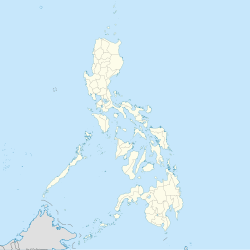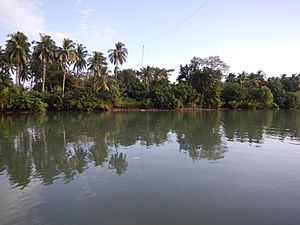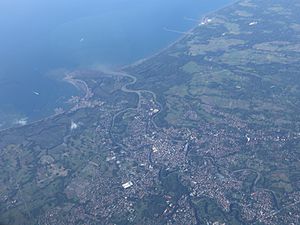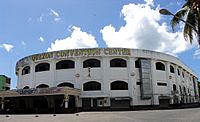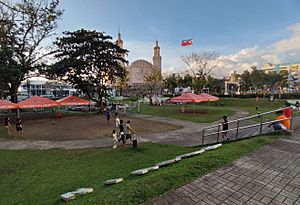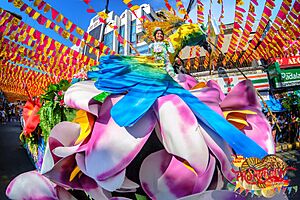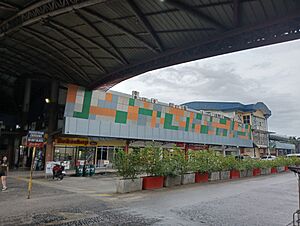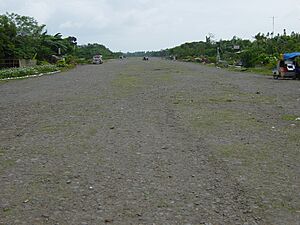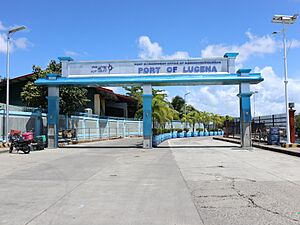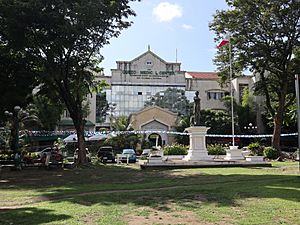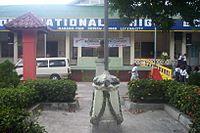Lucena facts for kids
Quick facts for kids
Lucena
|
|||
|---|---|---|---|
|
Highly urbanized city
|
|||
| City of Lucena | |||
|
Clockwise from top left: St. Ferdinand Cathedral, Tayabas Capitol (Quezon Provincial Capitol), Quezon Avenue, Lucena City Hall, Merchan Street, and Port of Lucena
|
|||
|
|||
| Motto(s):
BOOM Lucena!
|
|||
| Anthem: Ang Lungsod ng Lucena |
|||

Map of Calabarzon with Lucena highlighted
|
|||
|
OpenStreetMap
|
|||
| Country | Philippines | ||
| Region | Calabarzon | ||
| Province | Quezon (geographically only) | ||
| District | [[{{#property:P7938}} | — Lua error in Module:Wd at line 1804: attempt to index field 'wikibase' (a nil value).]] | ||
| Founded | November 3, 1879 | ||
| Cityhood (de jure) |
June 17, 1961 | ||
| Cityhood (de facto) |
August 20, 1961 | ||
| Highly urbanized city | July 1, 1991 | ||
| Named for | Lucena, Córdoba, Spain | ||
| Barangays | 33 (see Barangays) | ||
| Government
|
|||
| • Type | Sangguniang Panlungsod | ||
| Area | |||
| • Total | 80.21 km2 (30.97 sq mi) | ||
| Elevation | 61 m (200 ft) | ||
| Highest elevation | 1,687 m (5,535 ft) | ||
| Lowest elevation | 0 m (0 ft) | ||
| Population
(2020 census)
|
|||
| • Total | 278,924 | ||
| • Density | 3,477.42/km2 (9,006.5/sq mi) | ||
| • Households | 66,905 | ||
| Demonym(s) | Lucenahin, Lucentino | ||
| Economy | |||
| • Income class | First class, Highly Urbanized | ||
| • Poverty incidence |
|
||
| • Revenue | ₱ 1,853 million (2022) | ||
| • Assets | ₱ 3,359 million (2022) | ||
| • Expenditure | ₱ 1,745 million (2022) | ||
| • Liabilities | ₱ 1,377 million (2022) | ||
| Service provider | |||
| • Electricity | Manila Electric Company (Meralco) | ||
| Time zone | UTC+8 (PST) | ||
| ZIP code |
4300, 4301
|
||
| PSGC |
[https://psa.gov.ph/classification/psgc/?q=psgc/barangays/{{#pro000®code={{&provcode=
|
||
| IDD : area code | +63 (0)42 | ||
| Native languages | Tagalog | ||
| Website | lucenacity |
||
Lucena is a busy city in the Calabarzon region of the Philippines. It is the biggest urban area and the capital of Quezon Province. Lucena is a major center for business, healthcare, education, and government in its region.
Even though Lucena City is located within Quezon Province, it is politically independent. This means it manages its own affairs without the province telling it what to do. This gives Lucena a special status in the region.
There is a plan for a "Metro Lucena" area. This would connect Lucena City with nearby towns like Candelaria, Lucban, and Tayabas. The goal is to bring together their economies and resources to help the whole region grow.
As of the 2024 census, about 280,331 people live in Lucena City.
Contents
- Lucena's Past: A Journey Through Time
- Lucena's Location and Layout
- Lucena's Economy: Business and Industry
- Fun Places to Visit in Lucena
- Lucena's Culture and Celebrations
- How Lucena is Governed
- Getting Around Lucena
- Learning in Lucena: Education
- Famous People from Lucena
- Lucena's Sister Cities
- See also
Lucena's Past: A Journey Through Time
How Lucena Got Its Name
In the 1570s, Spanish explorers first came to this area, which was then called Kalilayan. Between 1580 and 1583, Franciscan priests founded a town named "Tayabas." Lucena was just a small part of Tayabas back then.
The Spanish first called the area "Buenavista" because it was so beautiful. Later, it was renamed "Oroquieta." About a hundred years later, pirates attacked the coast. The people built forts to protect themselves, especially in the areas now known as Cotta and Mayao.
Because of these forts, the place became known as Cotta, which comes from the Tagalog word kuta meaning 'fort'. As trade grew at the Cotta port and the pirates were defeated, Lucena started to become a bigger town.
On November 3, 1879, the name "Lucena" was officially chosen. It was named after Father Mariano Granja, a Spanish friar from Lucena, Spain. Father Granja helped develop the area, and Lucena became an independent town on June 1, 1882.
Lucena During Revolutions
During the 1896 Philippine Revolution, the people of Lucena fought for their freedom. José Zaballero led local fighters against the Spanish. Later, Miguel Arguilles and Jose Barcelona formed a revolutionary government in Lucena.
After the Philippines declared independence in 1898, General Miguel Malvar took control of Tayabas province. Don Crisanto Marquez became Lucena's first elected leader during the first Philippine Republic.
American Rule and Growth
Lucena played a part in the Philippine–American War. After the war, the Americans took over and started to set up new ways of governing.
In 1901, the provincial capital of Tayabas was moved to Lucena. This was because Lucena was in a central location and easy to reach from other towns. This move helped the Americans control the region better.
During this time, Lucena grew a lot. New roads, schools, and government buildings were built. This helped the city become more modern.
World War II and Freedom
On December 27, 1941, the Japanese forces took over Lucena. This event is known as "The Fall of Lucena." The Japanese wanted to control important places in the town.
However, local fighters and a group called the Hunters ROTC fought back strongly. They used their knowledge of the area to surprise the Japanese. These constant attacks made it hard for the Japanese to keep control.
By January 25, 1945, the Hunters ROTC guerrillas pushed the Japanese out of the city. The people of Lucena then made their defenses stronger, expecting the Japanese to try and come back.
The Japanese attempts to retake Lucena failed. On April 4, 1945, the American and Philippine Commonwealth troops arrived, bringing freedom to the province. After the war, Lucena worked hard to rebuild its buildings and businesses.
Becoming a City
Lucena officially became a city on June 17, 1961. This happened thanks to the efforts of Congressman Manuel S. Enverga. The city's first officials, led by Mayor Castro Profugo, started their work on August 20, 1961.
On July 1, 1991, Lucena was declared a "highly urbanized city." This meant it became fully independent from the province of Quezon in terms of politics and administration.
Lucena's Location and Layout
Lucena is about 130 kilometers (81 miles) south of Manila. The city center is located between two rivers, the Dumacaa River to the east and the Iyam River to the west. Seven other rivers and six creeks help drain water from the city.
Lucena has a port on Tayabas Bay. This port is very important for boats and ferries that travel between Lucena and other places in the region, even as far as the Visayas.
Because Lucena is the provincial capital, it has many government offices, businesses, banks, and services for the entire Southern Tagalog region.
Barangays: Lucena's Neighborhoods
Lucena is divided into 33 smaller areas called barangays. Each barangay has its own smaller sections called puroks and some have sitios.
- Barangay 1 (Poblacion)
- Barangay 2 (Poblacion)
- Barangay 3 (Poblacion)
- Barangay 4 (Poblacion)
- Barangay 5 (Poblacion)
- Barangay 6 (Poblacion)
- Barangay 7 (Poblacion)
- Barangay 8 (Poblacion)
- Barangay 9 (Poblacion)
- Barangay 10 (Poblacion)
- Barangay 11 (Poblacion)
- Barra
- Bocohan
- Cotta
- Gulang-Gulang
- Dalahican
- Domoit
- Ibabang Dupay
- Ibabang Iyam
- Ibabang Talim
- Ilayang Dupay
- Ilayang Iyam
- Ilayang Talim
- Isabang
- Market View
- Mayao Castillo
- Mayao Crossing
- Mayao Kanluran
- Mayao Parada
- Mayao Silangan
- Ransohan
- Salinas
- Talao-Talao
Lucena's Weather
Lucena has a climate where there isn't a clear wet or dry season. The wet season usually runs from June to November, sometimes lasting until December. The dry season is from January to May, but it can have some unexpected rain.
The average temperature is about 27°C (81°F). February is the coolest month, with temperatures dropping to 20°C (68°F). May is the warmest month, with temperatures reaching up to 35°C (95°F).
Lucena's Economy: Business and Industry
| Source: Philippine Statistics Authority |
|
Shopping and Trade
Most of Lucena's business activities happen in the city center, called the poblacion, and nearby areas. This is where many different businesses are located. As more people move to Lucena and new businesses open, commercial areas are also growing in other neighborhoods.
You can find many shops and services in the poblacion and other suburban barangays. Lucena City is home to SM City Lucena, which is the biggest mall in the city. Other shopping centers include Pacific Mall Lucena and Puregold Gulang-Gulang Lucena.
Local Industries
Many large factories and warehouses are located in Lucena's suburban areas. These include companies like San Miguel Brewery, Coca-Cola Bottlers Philippines, Inc., PepsiCo Philippines, Inc., and Nestlé Philippines. These companies handle sales, distribution, and transport of many different products.
About 46.62 hectares (115.2 acres) of Lucena City's land are used for industrial activities. These areas are important for manufacturing.
Lucena produces many products based on agriculture. These include dried and smoked fish, alcoholic drinks, bamboo and rattan furniture, and meat products.
Lucena is also known as the "Cocopalm City of the South." It has many coconut oil mills that make oil-based products like cooking oil, soap, and margarine. Companies like Tantuco Industries and JnJ Oil Industries, Inc. are well-known coconut oil producers in the city.
Car assembly and manufacturing plants have also opened in Lucena. These include Toyota-Lucena, Isuzu-Lucena, and Mitsubishi Lucena.
Fun Places to Visit in Lucena
Lucena is a popular place to visit because it has modern facilities, interesting cultural sites, and good transportation. It's easy to get to Lucena from other cities and towns in Luzon because of its wide road network. These roads help goods and services move smoothly around the clock, making Lucena an important center for trade and logistics.
One of the most famous places is the Quezon Convention Center. Many big events have been held here, including sports tournaments. This shows that Lucena can host large conferences, exhibitions, and sports events.
Lucena also has several sports complexes. The Kalilayan Civic Centre and Sentro Pastoral Auditorium are used for community and cultural events. The Alcala Sports Complex has hosted the Palarong Pambansa (national games) twice, in 1976 and 1989. Other sports venues include the Manuel S. Enverga University Foundation Gymnasium and Sacred Heart College Gymnasium.
A unique cultural spot is the Lucena Cockpit Arena. This is where traditional Filipino cockfighting takes place, which is a popular and old cultural activity in the region.
The Lucena City Government Complex is another important landmark. It houses many government offices and is the center of political activity in the city.
Cultural and Civic Spots
- Quezon Convention Center
- Lucena City Promenade (Bonifacio Drive)
- PNR Lucena Station
- Port of Lucena
Religious and Spiritual Places
- Saint Ferdinand Cathedral
- Our Lady of Lourdes Parish Church
Historical Buildings and Homes
- Cabana Ancestral House
- Calixto (Zaballero) Ancestral House
- Farmacia Chionglo
- Governor's Mansion
- Granja Panciteria
- Old Carlos Superdrug
Parks and Nature Sites
- Lucena Botanical Garden & Arboretum
- Perez Park
- Quezon National Park
- Talaba Eco Park
Lucena's Culture and Celebrations
Festivals and Fun Events
The city has many celebrations, and one of the most famous is the Pasayahan sa Lucena festival.
The Pasayahan sa Lucena is a festival that celebrates the connection between nature and people. The local government of Lucena organizes and hosts this event. It also shows off the unique way of life of the people in Lucena. The festival includes entertainment, delicious food, dancing, live music, and other fun activities.
The main event of the Pasayahan is the Grand Parade, also known as Mardi Gras. It features a parade of huge and colorful floats made by businesses and groups. There is also street dancing, marching bands, a hat competition, and a Carnival Queen competition.
The first Pasayahan in 1987 was a big success, and it has been held every year since. The festival attracts many people who come to have fun. Pasayahan also includes the Chami Festival, which promotes Lucena's local foods like chami (a noodle dish) and tinapa (smoked fish). Other events include the Binibining Pasayahan (a beauty pageant), a street fashion show, and street concerts. What started as a three-day event has now become a week-long or even month-long attraction for tourists.
The festival also happens around the same time as the Feast of St. Ferdinand, which is celebrated on May 30.
How Lucena is Governed
Local Government Structure
As a highly urbanized city, Lucena is independent from the province of Quezon. However, its residents can still vote and run in provincial government elections. The provincial government does not have political control over the city's local dealings. People in Lucena can also vote and run for positions in the provincial board and Congress.
The city of Lucena has a mayor, a vice mayor, and members of the city council called Sangguniang Panlungsod. These officials are elected for a three-year term and can serve up to three terms in a row.
Barangays also have elected officials: a Barangay Chairman and Barangay Council members, called Barangay Councilors. There is also an SK federation that represents the youth in the barangay, led by an SK chairperson and SK councilors. All these officials are elected every three years.
The main city government office is now the Lucena City Government Complex. Some offices are still located at the old Lucena City Hall in the poblacion.
Current Elected Officials
| City Government of Lucena (2025-2028) |
|
|---|---|
| Mayor | |
| Mark Don Victor B. Alcala | |
| Vice Mayor | |
| Roderick A. Alcala | |
| Sangguniang Panlungsod Members | |
| Danilo B. Faller | Americo Q. Lacerna |
| Wilbert Mckinly L. Noche | Patrick Norman E. Nadera |
| Benito G. Brizuela Jr. | Jose Christian O. Ona |
| Elizabeth U. Sio | Ryan Caezar E. Alcala |
| Rhaetia Marie C. Abcede-Llaga | Edwin J. Pureza |
| ABC President | |
| Reil Briones | |
| SK Federation President | |
| Rolden C. Garcia | |
Getting Around Lucena
Public Transportation Options
Land Travel
Lucena City has a main transportation hub called the Lucena Grand Central Terminal (Lucena GCT). This terminal is also home to the main offices of the Lucena City Land Transportation Office (LTO).
Buses connect Lucena to cities like Pasay and Quezon City in Manila. UV Express vans connect Lucena to nearby towns in Laguna and other parts of Quezon. Bus companies like JAC Liner and JAM Liner offer rides between Manila and Lucena.
Lucena also has many jeepney routes. These routes start from the city center and go to major barangays and nearby towns.
Thousands of tricycles also operate in the city. To help with traffic, the local government started a program where tricycles are assigned specific colors for morning, afternoon, or evening use. Green tricycles operate in the morning, while yellow ones are for the afternoon and evening.
An extension of the South Luzon Expressway (SLEX) is being built and will end in Lucena. There are also plans for another expressway to Bicol. Taxis and car rental services are also available.
Air Travel
There is a Lucena Airport, also known as Landing. However, it is no longer used for light aircraft because a road was built across its runway.
Train Services

The Philippine National Railways (PNR) is working to fix up the train lines that connect Manila to the Bicol Region. This includes stops in Quezon province, like the PNR Lucena station. This station used to be a major spot for passengers and cargo when trains were the main way to travel to Manila. Modern, air-conditioned trains are planned for this route.
Even though it's being renovated, the Lucena station is still active. It serves passengers traveling to and from San Pablo City every day.
Sea Travel
The Passenger Ferry Terminal in Lucena has RORO (Roll-on/Roll-off) vessels. These ships carry passengers and vehicles across Tayabas Bay to islands like Marinduque, Romblon, and Masbate.
The Port of Lucena, located in Dalahican, is known as a main gateway for Southern Luzon. It is about 27 nautical miles (50 km) from Dalahican. Ferry services like Montenegro Shipping Lines and Star Horse Shipping Lines operate here.
Staying Connected: Communication
Lucena City has both landline and mobile phone services from companies like Philippine Long Distance Telephone Company (PLDT) and Digitel Telecommunications. Major mobile phone providers include Globe, Smart, and DITO Telecommunity. Wi-Fi services are also available from providers like Converge ICT.
Hospitals and Healthcare
Lucena has both private and public hospitals. Both types of hospitals offer good healthcare services. They mainly differ in the types of medical and diagnostic equipment they have.
Here are some hospitals in the city:
- Lucena United Memorial District Hospital
- Lucena MMG General Hospital
- Mt. Carmel Diocesan General Hospital
- Lucena United Doctors Hospital and Medical Center
- St. Anne General Hospital
- Quezon Medical Center (Quezon Memorial Hospital)
- St. Mary's Hospital
- Quezon MMG Medical Plaza
Learning in Lucena: Education
Lucena City has many schools for different age groups. There are public and private schools for pre-school, primary (elementary), and secondary (high school) education.
For higher education, students can choose from various colleges and universities. These institutions offer different degree programs like Liberal Arts, Arts and Sciences, Engineering, and Information Technology. Some of these schools include the Lucena Campus of the Manuel S. Enverga University Foundation (MSEUF), Sacred Heart College, Maryhill College, and Southern Luzon State University.
Other schools include St. Anne College Lucena, ABE International College of Business and Economics, Philtech Institute of Arts and Technology Inc. (PIAT), Columbus College-Lucena, AMA Computer College-Lucena, and STI College Lucena.
There are also many day-care centers throughout the city for younger children.
Famous People from Lucena
- Bonifacio Bosita – A Filipino politician and former representative.
- Encarnacion Alzona – A famous historian and National Scientist of the Philippines. She was the first Filipino woman to earn a Ph.D..
- Fides Cuyugan-Asensio – A National Artist of the Philippines for Music, known for her contributions to music and culture.
- Jenny Miller – A TV and film actress.
- Jessie Dellosa – The 43rd Chief of Staff of the Armed Forces of the Philippines, a respected military leader.
- Mau Marcelo – The first winner of Philippine Idol.
- Neil Ryan Sese – A film and theatre actor, recognized for his strong performances.
- Nilo Alcala – A Filipino composer who won the 2019 American Prize in Composition. He is the first Philippine-born composer to be asked to write music for the Grammy Award-winning Los Angeles Master Chorale.
- Paz Márquez-Benítez – A Filipina short-story writer, celebrated for her literary works.
- Proceso Alcala – A Filipino politician and former Secretary of the Department of Agriculture.
- Zaijian Jaranilla – A Filipino actor famous for playing Santino in the TV show May Bukas Pa.
- Zymic Jaranilla – The sibling of actor Zaijian Jaranilla, who is also an actor.
Lucena's Sister Cities
 Tayabas City, Philippines
Tayabas City, Philippines General Santos, Philippines
General Santos, Philippines Calabanga, Camarines Sur, Philippines
Calabanga, Camarines Sur, Philippines Cabanatuan, Philippines
Cabanatuan, Philippines
See also
 In Spanish: Lucena (Filipinas) para niños
In Spanish: Lucena (Filipinas) para niños










